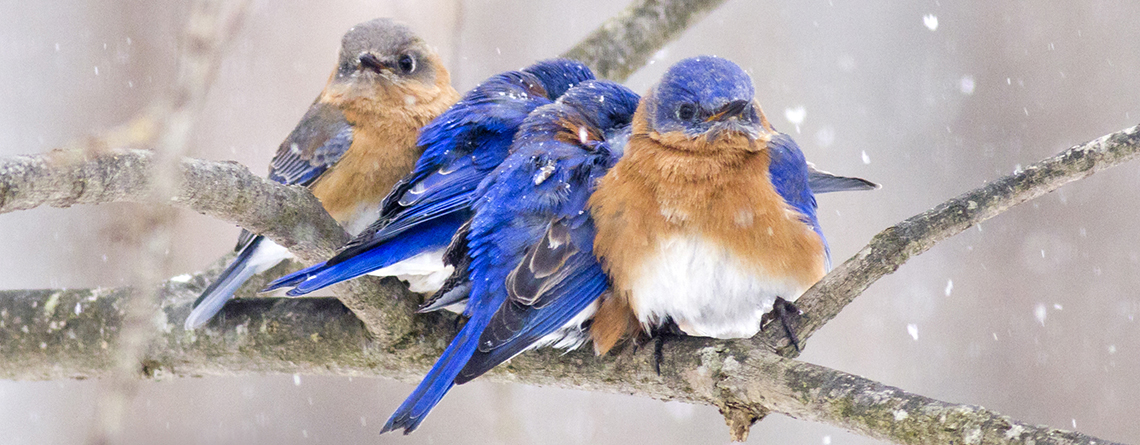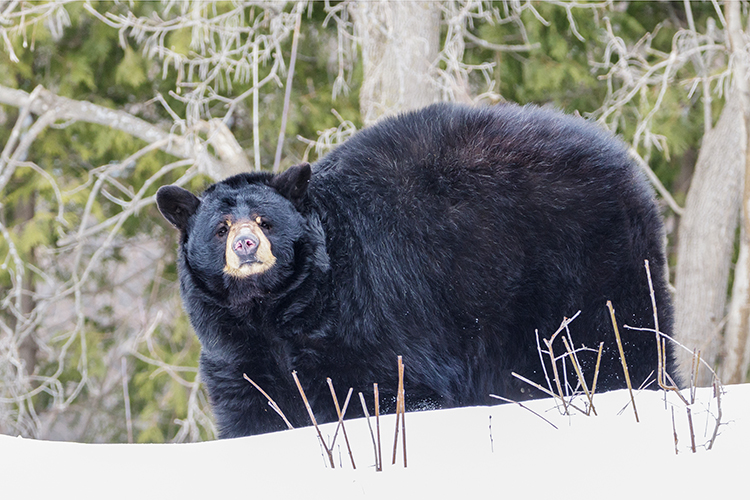Wicked Winter Survival Adaptations
January 01, 2021
It's no secret that New England winters can be . . . well, a bit bracing. Some folks relish being outdoors in the crisp, cold air while others would rather settle into a warm burrow and hibernate away the cold months, but we all find ways to adapt to winter weather.
And while we're piling on layers of cozy clothing and firing up the furnaces in our homes, the wildlife that overwinters in Massachusetts relies on some pretty amazing adaptations to survive the coldest days and nights.
Ruffle a Few Feathers (& Some Fur)
Birds that overwinter in cold climates grow additional feathers when the cold sets in and will fluff them up to create air pockets that increase insulation by trapping heat.
A few species, like Eastern Bluebirds, will huddle together to further reduce heat loss.
Similarly, most mammals grow additional fur in winter and many also huddle for warmth. Usually, they do so with their own kind, but otters may take up residence in a beaver lodge or muskrat den to escape the cold—even if it's already occupied!
Getting Cold Feet
Ever wonder why birds' feet don't freeze? Their legs are made mostly of tendon with very little muscle or blood flow, which reduces heat loss.
Even so, birds have tricks to keep their legs warm. You'll often see birds in winter standing on one foot, tucking the other into their bodies, then alternating when the standing foot needs a respite.
Waterfowl, gulls, and other large-footed waterbirds take things a step further with a special "countercurrent" circulatory system. The veins and arteries in their legs run right next to each other so the warm blood from their heart heats the cold blood returning from the feet. This keeps them just warm enough so they don't freeze when standing on ice.
Sleep It Off
Many animals spend the coldest months in torpor, a state of dormancy in which they lower their metabolic rate and body temperature to conserve energy. In endothermic or "warm-blooded" animals like woodchucks and bats, this is called hibernation; in ectothermic or "cold-blooded" animals like frogs and snakes, the metabolic processes are different, so it is referred to as brumation.
There are different kinds of hibernation. "True hibernators" enter a very deep state of dormancy that includes a dramatic drop in heart rate, breathing, and body temperature. For example, a hibernating woodchuck's internal temperature may plummet to 38°F from a normal average of 99°F.
Other mammals, like bears, are not true hibernators, so they will enter a "shallower" state of torpor, making it easier to wake up for short stints throughout winter to forage for food when the weather warms or to react to danger.
Terrestrial frogs and snakes will find places to brumate in rock crevices or under leaf litter that is below the frost line or otherwise protected from freezing, while aquatic frogs will look for similarly protected hiding spots near water or in mud.
Likewise, some birds can go into a state of daily torpor at night, lowering their metabolism for just a few hours to weather the coldest temperatures.
Buried Alive
Most of our native turtle species spend the winter at the bottom of frozen ponds, lakes, and rivers, where they bury in the mud and underwater vegetation, or even a muskrat burrow. When water approaches its freezing point of 32°F, its density decreases, creating a layer at the bottom that is just above freezing and warm enough for turtles to survive the winter.
Turtles don't necessarily go into torpor. However, you may see turtles moving around under the ice on warmer winter days. How do they survive for so long with minimal oxygen? They dial down their metabolism, relying on stored fat and sugar for energy. But this process creates lactic acid as a byproduct, and too much lactic acid buildup can kill them. Fortunately, the alkaline calcium in their shells helps neutralize the acid—a unique adaptation, indeed!
When I Say Freeze, You Freeze
One of the most ingenious strategies to deal with extreme cold involves some nifty chemistry—a few specialized species of frogs can tolerate freezing completely solid while in a state of brumation. How? Antifreeze! Normally, water stored in the blood and vital organs creates ice crystals when it freezes, which causes enough damage to kill most animals.
But Gray Tree Frogs, Wood Frogs, and (to a lesser degree) Spring Peepers can build up glycerol (a kind of sugar alcohol) in their bloodstream, which reduces the amount of stored water in their vital organs, allowing them to thaw out and return to business as usual in the spring.
Adult Mourning Cloak butterflies manage this trick, too, while overwintering in tree cavities and the like—this allows them to be among the first butterflies to emerge each year in spring.
More About Wildlife in Massachusetts
Wildlife in Massachusetts uses a remarkable array of traits to navigate our changing world. Discover how local mammals, birds, and amphibians adapt to more than just the cold.
Upcoming Wildlife Programs
See MoreSpring Migration Bird Walk
-
Pleasant Valley Wildlife Sanctuary, Lenox
-
Friday, April 25
7:00-8:30am
Adults
Vacation Week Trailside Explorers: Geology
-
Blue Hills Trailside Museum, Milton
-
Friday, April 25
12:30-1:30pm
Adult/Child pairs - 6 - 10 years
Touch Tank Time
-
Joppa Flats Education Center, Newburyport
-
Friday, April 25
2:00-4:00pm
Families - children 0 - 17
For The Birds: Accessible Bird Sit
-
Felix Neck Wildlife Sanctuary, Edgartown
-
Saturday, April 26
8:00-9:00am
Adults & Families - 0 - 17
Spring Bird Walk along the Neponset River
-
Neponset River Greenway, Milton
-
Saturday, April 26
9:00-11:00am
Adults
Vultures
-
Park Hill Orchard, Easthampton
-
Saturday, April 26
9:00-11:00am
Adults
Stay Connected
Don't miss a beat on all the ways you can get outdoors, celebrate nature, and get involved.




